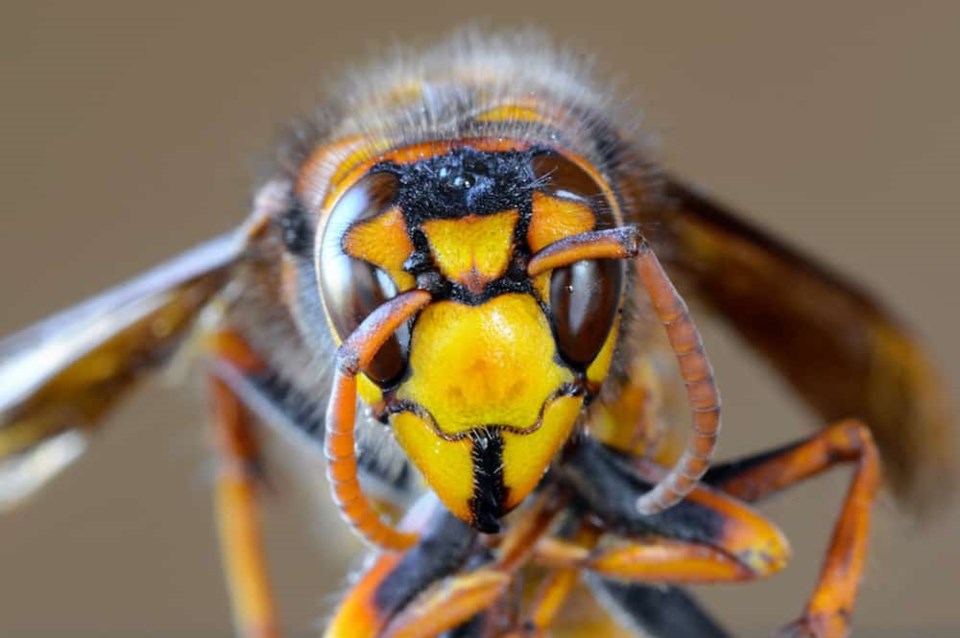An Asian giant hornet was discovered in B.C. two weeks ago, confirms Provincial Apiculturist Paul van Westendorp.
A sterile worker was discovered in B.C. close to the United States border, but Westendorp says it is less concerning than finding a queen.
"When you deal with a queen they will have the capability to produce, and that's what we don't want," he explains to Vancouver Is Awesome in a phone interview.
Just a couple of days ago, the first-ever Asian giant hornet nest in the U.S. was discovered just south of the B.C. border in Blaine, Washington.
Westerndorp notes that the B.C. specimen was found approximately two-and-a-half kilometres north of where the nest is located.
"The fact that these sightings have been made over the last few months indicates the presence of more than just one nest. There will be another nest in Blaine or in the vicinity of Blaine," he adds.
Despite the presence of more specimens and the discovery of a nest, Westerndorp says it isn't a cause for mass hysteria. While they can be dangerous when their nests are disturbed, they are not actively attacking humans. That said, he emphasizes that you should not disturb their nests--which are typically located on the ground or in crevasses.
Disturbing a nest will put them on the attack. And a sting packs a mighty wallop.
A Vancouver Island man says the sting felt as though hot thumbtacks had been stuck into his leg. Further, he experienced “throbbing muscular aches” in his legs for about 24 hours.
An invasive species, the Asian Giant Hornet (Vespa mandarinia), is commonly referred to as the 'murder hornet.' Normally found in the forests and low mountains of eastern and southeast Asia, it remains unclear how they arrived in North America. Their moniker — perhaps better suited for a comic book title or rock band name — was coined in Japan.
An Asian giant hornet nest was previously discovered and successfully destroyed last year in Nanaimo on Vancouver Island.
First-ever Asian giant hornet nest discovered in the United States
After weeks of trapping and searching, Washington State Department of Agriculture (WSDA) entomologists located an Asian giant hornet nest on a property in Blaine on Oct. 22.
The agency plans to attempt an eradication of the nest on Saturday, Oct. 24.
The WSDA shared a video of the nest to its Facebook page Friday.
In a news release, the WSDA explains how the successful detection of a nest comes after a trapper collected two live Asian giant hornets on Oct. 21, caught in a new type of trap the agency had placed in the area. Two more hornets, also living, were found in another trap the morning of Oct. 22 when WSDA staff arrived in the area to tag the previously trapped hornets with radio trackers and follow one back to its nest.
The entomologists were able to attach radio trackers to three hornets, the second of which lead them to the discovery of the nest, found about 4 p.m. on Oct. 22.
The nest is inside the cavity of a tree located on private property near an area cleared for a residential home. While Asian giant hornets normally nest in the ground, they are occasionally found nesting in dead trees. Dozens of the hornets were seen entering and exiting the tree while the WSDA team was present.
The property owner has already provided permission for WSDA staff to eradicate the nest and remove the tree, if necessary.
WSDA has been actively searching for Asian giant hornet nests since the first such hornets were caught earlier this year. The first confirmed detection of an Asian giant hornet in Washington was made in December 2019 and the first hornet trapped in July of this year. Several more were subsequently caught, all in Whatcom County.
Using a network of traps, some set by WSDA staff and hundreds more placed by citizen scientists and other cooperators throughout the state, the entomologists have been diligently tracking sightings of the Asian giant hornet in an ongoing effort to find nests to eliminate them.
The buzz about Asian giant hornets
• If you find a nest, do not disturb it. Leave the area.
• Stings are rare but could occur if the nest is disturbed.
• Because of the larger amount of venom injected, a sting can be very painful and cause localized swelling, redness and itching.
• Treat a sting similar to wasp or bee stings by putting ice or a cold compress on the site to reduce inflammation and spread of venom.
• Do not rub the site because it will spread venom.
• People who are stung multiple times (10 or more) have a higher risk of developing toxic or allergic reactions, lightheadedness or dizziness.
• People who are stung multiple time or who develop symptoms of toxic or allergic reactions are advised to seek medical attention immediately.
• If you think you’ve spotted an Asian giant hornet, call the Invasive Species Council of B.C. at 1-888-933-3722, or via the council’s “Report Invasives” mobile phone app, or online HERE.
- With files from Carla Wilson / The Times Colonist and The Canadian Press.




